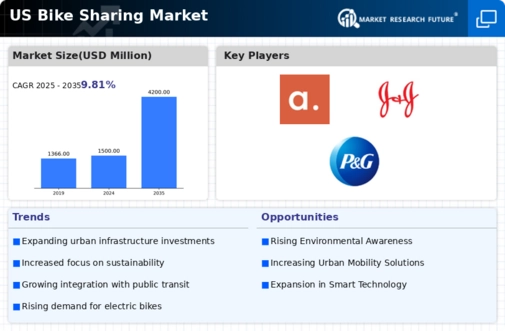Urban Mobility Solutions
Bike sharing is increasingly recognized as a vital component of urban mobility solutions in the US. As cities grapple with congestion and pollution, bike sharing offers an efficient alternative for short-distance travel. According to recent data, urban areas that have integrated bike sharing systems have seen a reduction in traffic congestion by up to 15%. This shift towards sustainable transportation options is likely to drive growth in the bike sharing market, as municipalities invest in infrastructure to support these initiatives. Furthermore, the convenience of bike sharing aligns with the preferences of younger generations, who prioritize accessibility and eco-friendliness in their commuting choices. As urban planners continue to embrace bike sharing as a key element of their transportation strategies, the market is poised for significant expansion.
Health and Wellness Trends
The bike sharing market is benefiting from a growing emphasis on health and wellness among the US population. As individuals become more health-conscious, the appeal of cycling as a form of exercise has surged. Data indicates that cities with bike sharing programs report a 20% increase in physical activity levels among residents. This trend is particularly pronounced in urban areas where access to traditional fitness facilities may be limited. The bike sharing market thus serves as a dual-purpose solution, promoting both transportation and health. Additionally, public health campaigns advocating for active lifestyles further bolster the market's growth potential. As more people recognize the health benefits associated with cycling, the bike sharing market is likely to see increased participation and usage.
Economic Factors and Affordability
The market is also shaped by economic factors that influence consumer behavior and affordability. With rising living costs in urban areas, many individuals are seeking cost-effective transportation solutions. Bike sharing offers an economical alternative to car ownership and public transit, with average costs ranging from $1 to $5 per ride. This affordability is particularly appealing to younger demographics, including students and young professionals, who may prioritize budget-friendly options. Furthermore, economic incentives such as subsidies and partnerships with local businesses can enhance the attractiveness of bike sharing programs. As economic conditions fluctuate, the bike sharing market is likely to adapt, potentially leading to innovative pricing models and expanded service offerings to meet diverse consumer needs.
Technological Advancements in Mobility
The bike sharing market is experiencing a transformative phase driven by technological advancements. Innovations such as GPS tracking, mobile applications, and smart locks have enhanced user experience and operational efficiency. For instance, the integration of mobile apps allows users to locate and reserve bikes easily, leading to a reported 30% increase in user engagement. Moreover, the implementation of data analytics enables operators to optimize bike distribution and maintenance, thereby improving service reliability. As technology continues to evolve, it is expected that the bike sharing market will further capitalize on these advancements, attracting a broader user base and increasing overall market penetration. The ongoing development of smart city initiatives also supports this trend, as cities seek to leverage technology to improve urban mobility.
Environmental Awareness and Policy Changes
The bike sharing market is significantly influenced by rising environmental awareness and corresponding policy changes in the US. As concerns about climate change intensify, both consumers and policymakers are advocating for greener transportation alternatives. Recent surveys indicate that over 60% of urban residents support initiatives aimed at reducing carbon emissions, which positions bike sharing as an attractive option. Additionally, various state and local governments are implementing policies that promote cycling infrastructure, such as dedicated bike lanes and parking facilities. These developments not only enhance the appeal of bike sharing but also create a more conducive environment for its growth. As environmental policies continue to evolve, the bike sharing market is likely to benefit from increased investment and support.














Leave a Comment